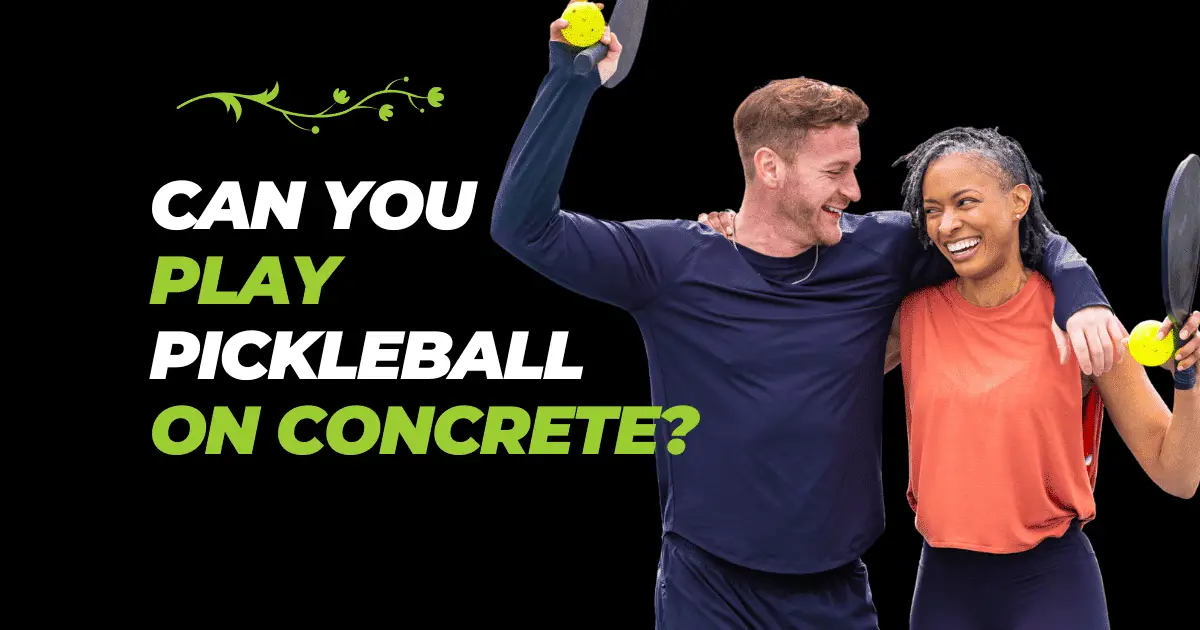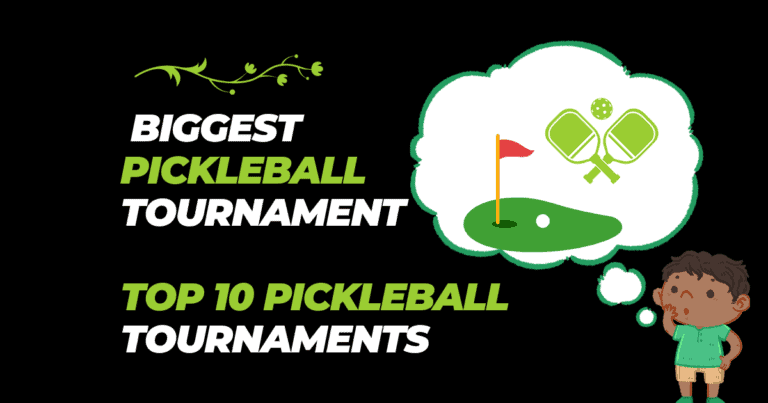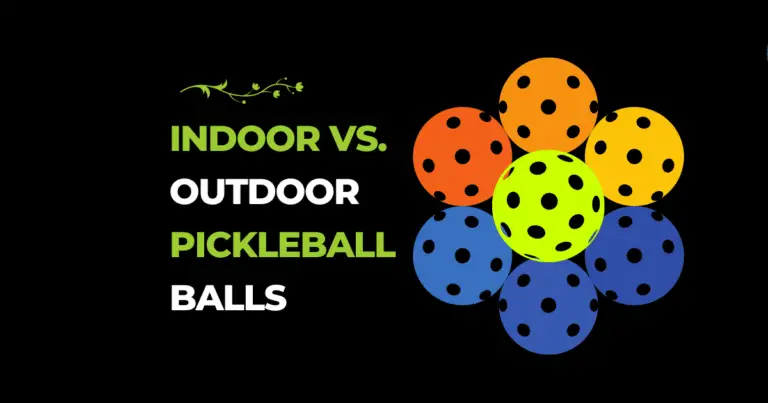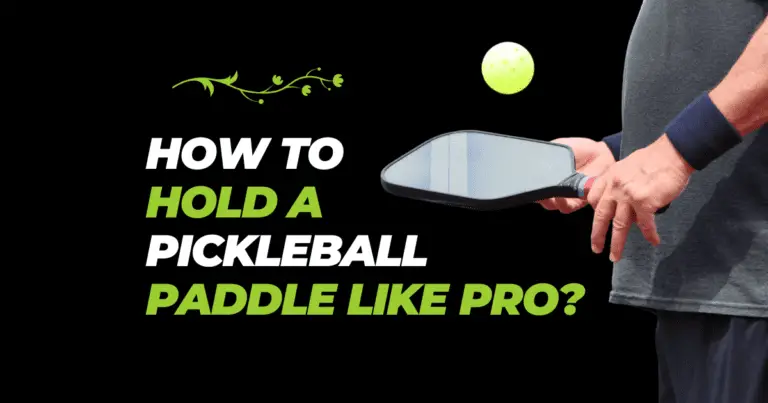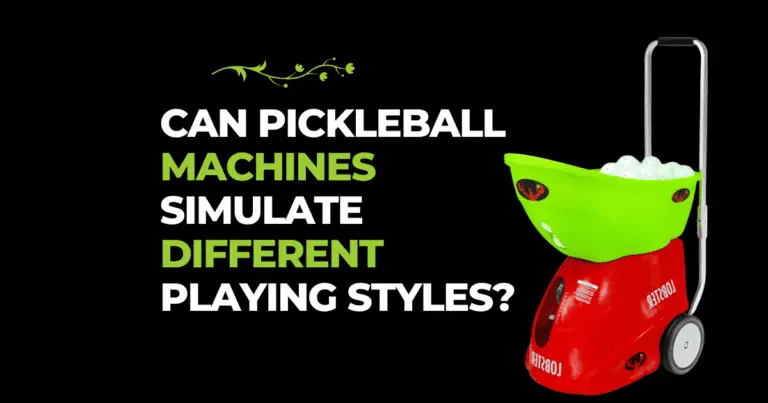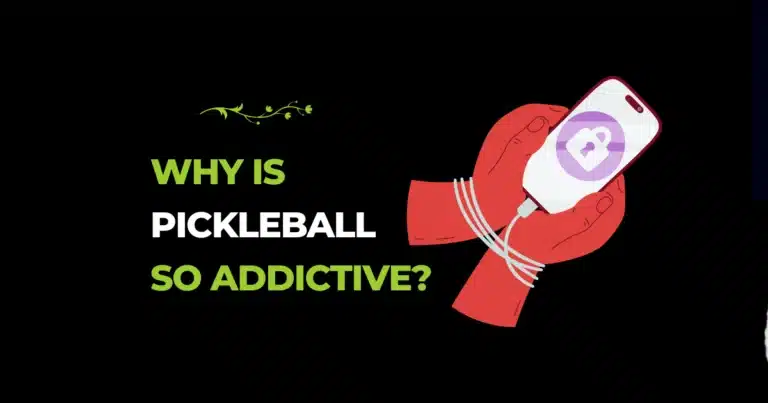Last updated on: August 23, 2023
Playing on Concrete Courts
Many pickleball players wonder if they can play on concrete courts, as concrete is a common surface for outdoor courts and driveways. The short answer is yes, you can absolutely play pickleball on a concrete court. But you have to consider some key things before playing on concrete :
Traction and Footing
Concrete provides a smooth, consistent surface for pickleball. However, some players find concrete too slick and struggle to get good traction when moving quickly in pickleball, especially when wearing shoes not designed for concrete. The surface can become slippery when wet as well. Using appropriate footwear with good tread helps significantly.
Joint Impact
The unforgiving hard surface of concrete can increase stress on ankles, knees, and other joints when playing. Using proper footwork technique and bracing on shots can mitigate this. Some players prefer to wear knee pads when playing extensively on concrete.
Temperature
Concrete absorbs and retains heat from the sun and can get very hot in warm weather. This can make playing uncomfortable or even dangerous in extreme heat. Avoid the hottest parts of the day and use sunshades if possible.
Surface Hazards
Cracked or broken sections of concrete can create tripping hazards. Make sure to check courts thoroughly and avoid uneven areas. Any major gaps or faults in the surface can interrupt play.
Bounce and Playability
Concrete provides an accurate and predictable ball bounce that many pickleball players enjoy. The ball rebounds well off the hard surface, though some find the pace can be slightly faster than softer surfaces like asphalt.
Indoor vs. Outdoor Concrete
Indoor concrete floors provide ideal pickleball playing conditions. The surface is protected from weathering and usually finished to be very smooth and consistent. Players do still need proper footwear for indoor concrete floors, but traction is less of an issue.
Pros of Concrete Courts
- Accessibility – Concrete is a common and inexpensive surface. Schools, driveways, tennis courts, and other facilities often have concrete areas that can be converted to pickleball courts. This makes the sport more accessible.
- Durability – Concrete holds up well over time with minimal maintenance. Cracks and pits need to be filled in, but otherwise concrete provides a long-lasting pickleball surface.
- Texture – Concrete provides reasonable traction for running and pivoting during play. The gritty surface is not as slick as very smooth courts.
- Low cost – Painting pickleball court lines on an existing concrete slab is an affordable option. Temporary lines can also be applied with tape. Far less expensive than installing a specialized acrylic or asphalt court.
Cons of Concrete Courts
- Rough surface – Concrete tends to be rougher and more abrasive than an asphalt or acrylic court designed for pickleball. The texture can wear down shoes and be hard on feet during longer play sessions.
- Inconsistent bounces – The ball does not bounce as cleanly on uneven or cracked concrete. This can negatively impact rallies. Shot consistency is reduced.
- Higher risk of injury – Due to the rigid surface, falls and dives onto concrete can lead to scrapes, bruises, and other minor injuries. Joint pain may also increase.
- Challenging maintenance – Concrete shows dirt, debris, and stains readily. Power washing and reapplying court lines is needed on a regular basis. Cracks and pits must be repaired properly.
Playing Tips for Concrete Courts
- Choose court shoes wisely – Well-cushioned, flexible court shoes are essential. Avoid playing on concrete in bare feet or running shoes.
- Check court lines – Make sure court lines are clearly visible. Faint or uneven lines make it hard to determine boundaries.
- Watch for cracks and pits – Avoid tripping in problem areas—alert facilities management to hazardous cracks requiring repair.
- Keep debris off the court – Concrete shows all debris clearly. Remove any gravel, sticks, or leaves before playing.
- Limit dive plays – Think twice before diving to make a shot. The unforgiving surface can lead to scraped skin or other injuries.
- Stay hydrated – Concrete reflects more heat. Drink plenty of fluids during play on hot sunny days.
- Time play carefully – Concrete retains heat in the evenings, which can impact ball bounce. Mornings or cooler days may be best.
Surface Options to Improve Concrete Courts
There are products available to help improve concrete courts for better and safer pickleball play:
- Court resurfacing – Applying an acrylic coating creates a smoother and more consistent ball bounce. Professional installation is recommended.
- Court tiles – Interlocking, modular court tiles attach on top of concrete to produce a seamless playing surface. Tiles are permeable and provide cushioning.
- Tempered glass panels – Some companies offer large tempered glass panels that can be positioned on concrete to create slick, consistent courts tailored for pickleball.
- Court paint – Special paint with silicone beads or acrylic layers can help fill small pits and cracks in concrete while creating a more consistent ball bounce.
- Court repair – Filling cracks and significant pits with court patch products helps level the surface and improve playability.
Pickleball Equipment for Concrete
To maximize safety and performance when playing pickleball on concrete, use the right paddle and shoes:
Paddle:
Choose a graphite or composite pickleball paddle rather than wood. The firmness of the paddle face will provide more control on a fast concrete surface. Heavier paddles around 7.5-8.5oz also give stability. Edgeless paddles limit vibration and joint strain from mis-hits.
Shoes:
Prioritize non-marking, flat-soled court shoes with good lateral support. Herringbone soles or gum rubber outsoles improve traction. Paddle sports shoes designed for racquetball, squash, or badminton adapt well to pickleball on concrete.
Clothing:
Avoid apparatus that could catch on concrete, like baggy clothing or jewelry. Knee pads and elbow pads can also be beneficial for safety.
Making Concrete Courts Pickleball-Friendly
If you want to paint pickleball lines and designate courts for concrete surfaces, be sure to use products suitable for bonding and marking concrete. Popular options include Behr PPU Floor Paint, Java Sports Acrylic Court Marking Paint, and Glit Striping Chalk.
Laying down temporary court boundary lines with painter’s tape can also work well. Another option is using chalk or chalk-style tape to mark lines instead of permanent paint. This allows flexibility if you want to convert the concrete space for other sports or activities.
For outdoor residential concrete, installing pickleball-specific sport court tiles over the surface provides a modular and ideal playing field. Driveway cracks and imperfections are covered up. Court tiles stand up well to weather and can be removed later if desired.

Concrete Surface FAQs
Is playing pickleball on concrete bad for the knees?
The rigid concrete surface can increase stress on knees over time. Proper footwear and being careful when pivoting helps reduce impact. Those with prior knee injuries should use extra caution.
How smooth should concrete be for pickleball?
A lightly textured surface provides sufficient traction for play. However, smooth-troweled concrete offers the most consistent ball bounce. Filling cracks and pits helps create a flat surface.
What type of shoes are best for pickleball on concrete?
Flexible, cushioned court shoes with good lateral support help guard against injury on concrete. Sturdy cross trainers or running shoes also work well. Avoid playing in bare feet.
Can you play pickleball on patterned concrete?
Patterned or stamped concrete has indented designs that impact ball bounce. The ball may bounce out of play unpredictably. A consistent surface is ideal.
How much does it cost to resurface concrete for pickleball?
Resurfacing concrete typically costs around 3-7 per square foot depending on the product used. So a regulation-sized pickleball court (20′ x 44′) would be about $2,500 – $6,000 for professional installation.
Is concrete better or asphalt for pickleball?
Asphalt provides a smoother, more consistent bounce preferred by most players. But well-maintained, professional-quality concrete courts allow for very competitive pickleball too. Both produce reasonable play.
What type of shoes works best on concrete courts?
Shoes with good traction from tread patterns work best. Look for lateral support and avoid running shoes. Basketball or tennis shoes designed for indoor courts can perform well.
Should I wear knee pads when playing on concrete?
Knee pads can help absorb impact on concrete and reduce joint strain. They are recommended for players who experience knee pain or discomfort when playing frequently on hard surfaces.
How can I deal with the heat on hot days?
Avoid midday sun if possible. Use shade structures, umbrellas or canopy tents if available. Take more frequent breaks and stay hydrated. Dampen shirt or wear cooling headband to stay cooler.
What can I do if the court has major cracks or faults?
Check with the property owner to see if repairs are planned. Use extra caution around damaged areas or badly cracked courts. Uneven surfaces increase injury risk. Consider finding alternate court if very rough.
Should I use a different paddle or ball on concrete?
You can, but it’s not required. Composite paddles with some flex may help with control. Outdoor balls designed for asphalt play well on concrete too.

